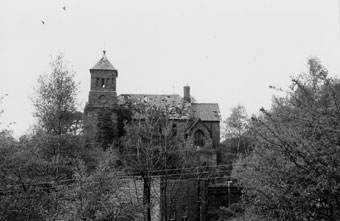
"Somebody or Other's folly"
or Baxter's Monument, to give it it's correct name. Constructed
around 1850 by William Hancocks in memory of the 17th century
cleric Richard Baxter. It still stands today on private land
adjacent to the factory. |

Blakeshall Common School. Constructed
around 1855 again by the landowner William Hancocks. It
was to cater for the children of the families of the small
village that used to occupy the site before the factory
was built. Children from the neighbouring Rock Houses also
used to attend. From the 1890's it was used as a mission
chapel, eventually falling into disuse by the 1920's. It
was later used by the Home Guard during the war. From Albert's
description of the famous preacher I suspect he was referring
to Richard Baxter, who although he may have been associated
with the chapel, would have never visited as he died around
1691. This building was sadly demolished around 1982.
Click
here for more about Richard Baxter
Click
here for more photos of the school/chapel
|
|
The hall became our Civil Defence H.Q. some of our
equipment was stored in the "old privies" outside. On occasions
I slept in an upstairs room. A cold bleak room with a tiny
fireplace and blacked out windows, reached via a narrow
stairway. They lived tough in those days. If, as reputed,
this famous Preacher or his disciples lived and taught there,
they must have been hardy sort of chaps.
About 100yds further on, between ever steepening
banks of sandstone, we came to a huge double door, big enough
to drive a double decker bus through, beyond which we entered
through a small door to a tunnel-like chamber about 40yds
long, with another huge pair of doors at the other end.
It acted like an air-lock housing also, this was later as
recruitment of labour was stepped up, a Timekeepers office,
complete with clocking in stations. All the tunnels were
the same width as the outside roadway (about 25ft). Main
ones maybe a bit wider. All tunnels had kerbstones at the
side, a short one foot ledge and the wall rose straight
up for about l5ft then arched over, Hewn out of solid sandstone
they were sprayed to harden the crust, and painted a creamy-buff
finish. The top took the huge air-ducts and ventilation
that brought warm air in and foul air out. The method of
construction of the tunnels made them self-supporting.
Through the second doorway to the factory proper,
the tunnels, empty at the time, streched into the distance,
a quarter of a mile. This was only the main one, five in
all. 1, 2 and 3 ran parallel about 50yds apart. 4 and 5
were at right angles to entrances the other side of the
hill, The latter housed the offices, The R.A.F. also had
some other entrances. Tunnels 1, 2 and 3 were linked by
interjoining bays every few yards , about 36 of them. My
bay, the Polishing Shop was between 1 and 2 right at the
far end. No. 35. Florescent lighting was installed throughout,
excepting for spot lights on lathes, None of us had seen
it before. The flickering when switched on was disconcerting
at first. We came to appreciate its absence of glare and
shadow. The vastness of the place took ones breath away.
Seven miles of tunnels.
Naturally each wanted to see his Departnent. It came
as a shock to see nearly every bay barren and empty. At
least in the Polishing Shop the lathes and stands were in
position. Obviously it would be some time before any production
would be going. The next few weeks would be a drag. These
transfers were carefully programmed, all we could do was
to be patient.
At one o'clock sharp we met for dinner. Cementation,
that's the name of one of the big contractors ( a world
wide construction firm) had cleaned out one of their Canteen
huts, we used it for some weeks, Dinner was laid out as
if it were a banquet. V.I.P. treatment that boosted our
ego no end.
Our guides never let us out of sight until it was
time to get the coach back to No. 1. and the bus home. Our
transfer to Drakelow was complete and excepting for one
occasion, never set foot in No. 1 until after the War. After
that first day the coach picked us up en-route every morning
for a few weeks until our Hostels were ready.
|
![]() Back
to home page
Back
to home page ![]() Drakelow
Unearthed
Drakelow
Unearthed
